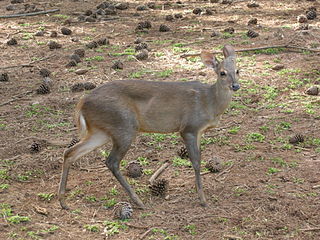 W
WBrockets or brocket deer are the species of deer in the genus Mazama. They are medium to small in size, and are found in the Yucatán Peninsula, Central and South America, and the island of Trinidad. Most species are primarily found in forests. They are superficially similar to the African duikers and the Asian muntjacs, but unrelated. About 10 species of brocket deer are described.
 W
WThe dwarf brocket, or chunyi, is a small species of deer native to the Andean highlands in western Bolivia and southeastern Peru, where it is found in forest and páramo. Its pelage is reddish-brown with dark grey foreparts and neck. The underparts are lighter brown, and the muzzle short and thick. It weighs around 11 kg.
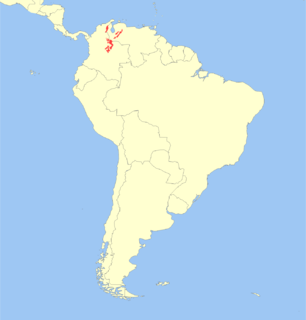 W
WThe Mérida brocket, also known as the Meroia brocket or rufous brocket, is a small species of deer. It is found in forest and páramo at altitudes of 1,000–3,500 metres (3,300–11,500 ft) in the Andes of northern Colombia and western Venezuela. It was once treated as a subspecies of the similar little red brocket, but has been considered a distinct species since 1987, though as recent as 1999 some maintained it as a subspecies.
 W
WThe carunculated caracara is a species of bird of prey in the family Falconidae. It is found in páramo in the Andes of Ecuador and Colombia. It is generally uncommon to fairly common.
 W
WThe eastern mountain coati or eastern dwarf coati is a small procyonid found in cloud forest and páramo at altitudes of 2,000–4,000 metres (6,600–13,100 ft) in the Andes of western Venezuela. Until 2009, it was usually included as a subspecies of the western mountain coati, but the eastern mountain coati is overall smaller, somewhat shorter-tailed on average, has markedly smaller teeth, a paler olive-brown pelage, and usually a dark mid-dorsal stripe on the back. When the two were combined, they were rated as Data Deficient by the IUCN, but following the split the eastern mountain coati is considered endangered.
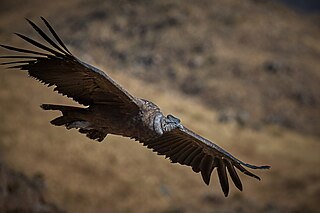 W
WThe Andean condor is a South American bird in the New World vulture family Cathartidae and is the only member of the genus Vultur. Found in the Andes mountains and adjacent Pacific coasts of western South America, the Andean condor is the largest flying bird in the world by combined measurement of weight and wingspan. It has a maximum wingspan of 3.3 m exceeded only by the wingspans of four water birds—the roughly 3.5 m maximum of the wandering albatross, southern royal albatross, great white pelican and Dalmatian pelican.
 W
WThe buff-tailed coronet is a species of hummingbird from the family Trochilidae. It is found in Colombia, Ecuador, and Venezuela. Distinguishing characteristics are the short bill, glittering green coloration, and buffy color under the remiges and rectrices. Like other hummingbirds, the buff-tailed coronet is often found in mid-level forest to canopy searching for flowers with nectar and some insects. This bird is commonly found from 1500–2400 meters above sea level.
 W
WThe cream-backed poison frog is a species of frog in the family Dendrobatidae endemic to Colombia. Its natural habitats are subtropical or tropical, high-altitude grassland, shrub-dominated wetlands, swamps, intermittent freshwater marshes, rural gardens, urban areas, and heavily degraded former forests. The cream-backed poison frog is one of the less-toxic of the family. It has undergone several name changes since its discovery. Originally called Dendrobates subpunctatus, its name was changed to Colostethus subpuctatus once the family Dendrobatidae underwent a division of species and genera other than Dendrobates were coined. Recently, minor skeletal differences have separated the cream-backed poison frog from the rocket frogs, and placed it in another genus entirely, Hyloxalus.
 W
WDice's cottontail is a species of cottontail rabbit in the family Leporidae. It is found in Costa Rica and Panama, in páramo and cloud forest habitats.
 W
WThe slaty flowerpiercer, Diglossa plumbea, is a passerine bird endemic to the Talamancan montane forests.
 W
WThe variable hawk is a polymorphic species of bird of prey in the family Accipitridae.
 W
WHesperocharis graphites, the marbled white or Mexican marbled white, is a butterfly in the family Pieridae. It is found in Mexico, Guatemala and Nicaragua. It is found in montane habitats, including cloud forests, open pastures and páramo grassland.
 W
WThe purple honeycreeper is a small Neotropical bird in the tanager family Thraupidae. It is found in the tropical New World from Colombia and Venezuela south to Brazil, and on Trinidad. A few, possibly introduced birds have been recorded on Tobago.
 W
WThe volcano hummingbird is a very small hummingbird, native to the Talamancan montane forests of Costa Rica and western Panama.
 W
WHyloscirtus is a genus of Neotropical frogs in the family Hylidae. This genus was resurrected in 2005 following a major revision of the Hylidae, with the distinguishing features being 56 transformations in nuclear and mitochondrial proteins and ribosomal genes. Of these species, 28 species, previously placed in the genus Hyla, were moved to this genus. The fingers and toes of these frogs have wide dermal fringes.
 W
WHyloxalus anthracinus is a species of frog in the family Dendrobatidae. It is endemic to Ecuador and occurs on the Cordillera Oriental and in the Mazán River, southern Ecuador. The name anthracinus means "coal black" and refers to the black dorsum of males.
 W
WThe little red brocket or swamp brocket, also known as the Ecuador red brocket, is a small, little-studied deer native to the Andes of Colombia, Ecuador and northern Peru, where found in forest and páramo at altitudes between 1,400 and 3,600 metres. It is one of the smallest brocket deer. The coat is reddish, and the legs and crown are blackish. As recently as 1999, some authorities included both the pygmy brocket and Merida brocket as subspecies of the little red brocket.
 W
WLynchius flavomaculatus is a species of frog in the family Craugastoridae. It is found in the Andes of southern Ecuador and northern Peru.
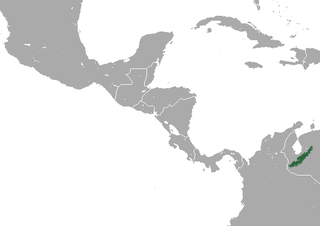 W
WThe Merida small-eared shrew is a species of shrew that is endemic to Venezuela.
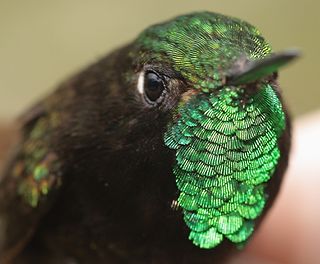 W
WThe Perijá metaltail is a species of hummingbird in the family Trochilidae. It is endemic to páramo and elfin forest at high altitudes of the Perijá Mountains in Colombia and Venezuela. It is threatened by habitat loss.
 W
WThe mountain tapir, also known as the Andean tapir or woolly tapir is the smallest of the four widely recognized species of tapir. It is the only one to live outside of tropical rainforests in the wild. It is most easily distinguished from other tapirs by its thick woolly coat and white lips.
 W
WMountain coatis are two species of procyonid mammals from the genus Nasuella. Unlike the larger coatis from the genus Nasua, mountain coatis only weigh 1.0–1.5 kilograms (2.2–3.3 lb) and are endemic to the north Andean highlands in South America.
 W
WThe eastern mountain coati or eastern dwarf coati is a small procyonid found in cloud forest and páramo at altitudes of 2,000–4,000 metres (6,600–13,100 ft) in the Andes of western Venezuela. Until 2009, it was usually included as a subspecies of the western mountain coati, but the eastern mountain coati is overall smaller, somewhat shorter-tailed on average, has markedly smaller teeth, a paler olive-brown pelage, and usually a dark mid-dorsal stripe on the back. When the two were combined, they were rated as Data Deficient by the IUCN, but following the split the eastern mountain coati is considered endangered.
 W
WThe western mountain coati or western dwarf coati is a small procyonid, found in cloud forest and páramo at altitudes of 1,300–4,250 metres (4,270–13,940 ft) in the Andes of Colombia and Ecuador. A population discovered in the Apurímac–Cuzco region of southern Peru has tentatively been identified as the western mountain coati, but may represent an undescribed taxon.
 W
WOidaematophorus nigrofuscus is a moth of the family Pterophoridae that is endemic to Venezuela. The type location is Páramo de Piedras blancas.
 W
WThe Pampas cat is a small wild cat native to South America. It is listed as Near Threatened on the IUCN Red List as habitat conversion and destruction may cause the population to decline in the future.
 W
WThe paramo ground tyrant, also known as the paramo ground-tyrant, is a species of bird in the tyrant flycatcher family, Tyrannidae. plain-capped ground tyrant was formerly considered to be a subspecies of M. alpinus but is now commonly treated as a separate species. The name "plain-capped ground tyrant" is sometimes used for M. alpinus.
 W
WThe paramo pipit is a species of bird in the family Motacillidae. It is found in Argentina, Bolivia, Colombia, Ecuador, Peru, and Venezuela. Its natural habitats are subtropical or tropical high-altitude grassland and pastureland.
 W
WPristimantis bogotensis is a species of frog in the family Craugastoridae, sometimes known as the Bogota robber frog. It is endemic to Colombia where it is only known from the Cundinamarca Department including the Bogotá area, on the Cordillera Oriental. Its natural habitats are tropical moist montane forests and high-altitude páramo grassland, but it adapts to disturbance and can also occur on pastureland, provided that some shrubs remain.
 W
WPristimantis buckleyi is a species of frog in the family Craugastoridae. It is found on the Andes of Colombia and Ecuador. Specifically, it occurs on the both flanks of the Cordillera Central and on the eastern flank of the Cordillera Occidental in Colombia, and on the Cordillera Real in Ecuador south Cayambe, at elevations of 2,500–3,700 m (8,200–12,100 ft) asl.
 W
WPristimantis curtipes is a species of frog in the family Craugastoridae. It is found in the Nariño Department of southern Colombia and in the western and eastern Andes of Ecuador south to Desierto de Palmira.
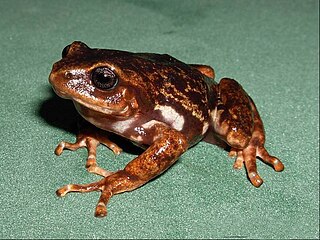 W
WPristimantis elegans is a species of frog in the family Craugastoridae. It is endemic to the Colombian Andes and occurs on the Cordillera Oriental in the Cundinamarca and Boyacá Departments. Common name elegant robber frog has been coined for it.
 W
WPristimantis lymani is a species of frog in the family Craugastoridae. Its common name is Lyman's robber frog. It is found in southern Ecuador and northern Peru. Its natural habitats are montane forests, sub-páramo, and páramo. These common frogs have been found under stones by streams as well as in large bromeliads on rocky slopes and cliffs. While common and having a stable population trend, it is suffering from habitat loss.
 W
WThe paramo seedeater is a species of bird in the family Thraupidae.
 W
WThe starry night toad is a species of toad in the family Bufonidae endemic to the Sierra Nevada de Santa Marta, Colombia. Its natural habitats are sub-Andean and Andean forests, sub-páramo and páramo at 2,000–3,500 m (6,600–11,500 ft) above sea level. Reproduction takes place in fast-flowing rivers. It is named after its unique coloration, being largely black with white spots.
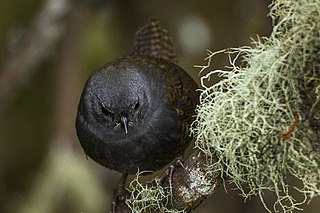 W
WThe Paramo tapaculo is a species of bird in the family Rhinocryptidae. It is found at altitudes of 2,600 to 4,000 metres in the Andes of northern Peru, Ecuador and southern Colombia. It has traditionally been treated as a subspecies of S. canus, but the two have different voices, leading to them being split into separate species in 2010.
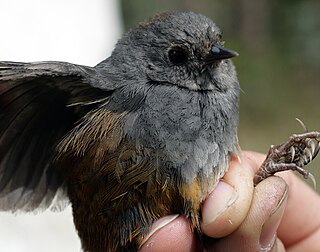 W
WThe Perijá tapaculo is a species of passerine bird in the family Rhinocryptidae (tapaculos). Endemic to the Serranía del Perijá mountain range on the Colombia–Venezuela border, the Perijá tapaculo is found at altitudes of 1,600–3,225 metres. Its body is 10 to 12 centimetres long and its tail is around 4 cm (1.6 in) long. Specimens have long been stored in museums, but the species was described only in 2015 based on sixteen specimens found between July 2008 and February 2009. It is considered vulnerable to extinction.
 W
WTelmatobius atahualpai is a species of frog in the family Telmatobiidae. It is endemic to the Cordillera Central of northern Peru and found in the San Martín and Amazonas Regions at 2,600–4,000 m (8,500–13,100 ft) asl.
 W
WThomasomys ucucha, also known as the ucucha thomasomys, is a rodent in the genus Thomasomys of the family Cricetidae. It is known only from high altitude forest and grassland habitats in the Cordillera Oriental of Ecuador. Seven other species of Thomasomys live in the same areas. First collected in 1903, T. ucucha was formally described as a new species in 2003 and most closely resembles T. hylophilus, which occurs further to the north. The species is listed as "vulnerable" in the IUCN Red List as a result of habitat destruction.
 W
WThe western mountain coati or western dwarf coati is a small procyonid, found in cloud forest and páramo at altitudes of 1,300–4,250 metres (4,270–13,940 ft) in the Andes of Colombia and Ecuador. A population discovered in the Apurímac–Cuzco region of southern Peru has tentatively been identified as the western mountain coati, but may represent an undescribed taxon.
 W
WThe sedge wren is a small and secretive passerine bird in the family Troglodytidae. It is widely distributed in North America. It is often found in wet grasslands and meadows where it nests in the tall grasses and sedges and feeds on insects. The sedge wren was formerly considered as conspecific with the non-migratory grass wren of central and South America.